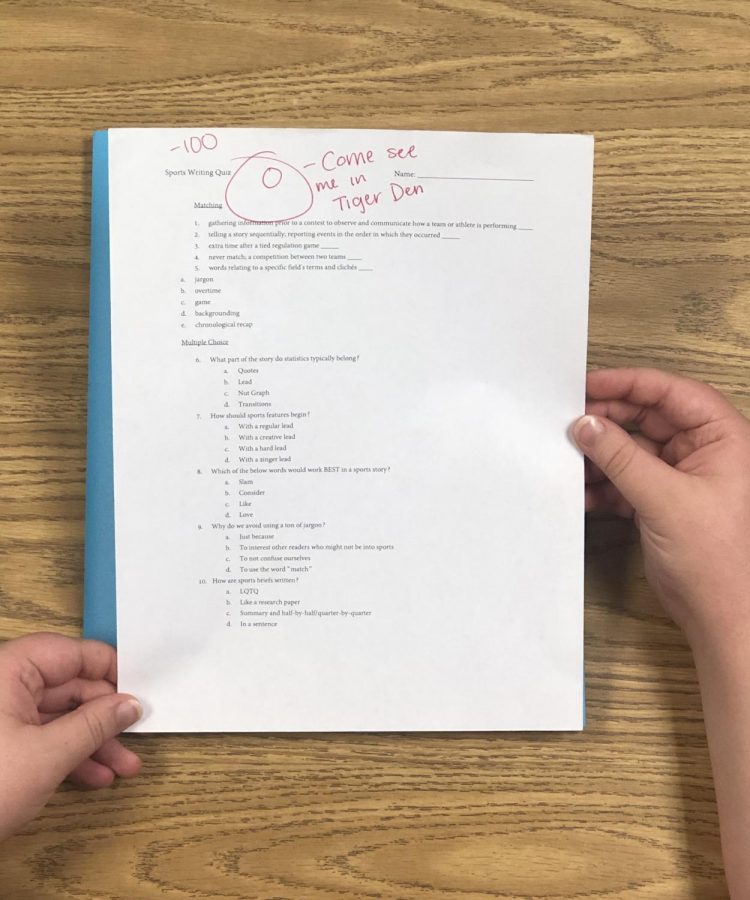Zeroing In On The Zero Tolerance For Zeros Policy
The Zero Tolerance for Zeros Policy has already begun filling teacher’s Tiger Dens to capacity as students begin to fall behind.
October 7, 2019
The Zero Tolerance for Zeros Policy- which is growing in popularity across America- doesn’t allow students to give up on getting the best possible grade they can and gives all students a chance to succeed. This new policy has recently been introduced to the Klein ISD community and is receiving both negative and positive feedback.
The Zero Tolerance Policy is important because it ensures that the students teacher does everything in their power to help the child receive the highest grade possible. There is a six step process in which the teacher and student follow to ensure that the student is getting the highest possible grade. Each day the student is late turning in their assignment the highest possible grade they can receive goes down. Students are first pulled into Tiger Den to make up the grade, if students do not complete their work in Tiger Den then they will receive a call home. If the student does not turn in the assignment following the call home, then they will receive ASD. Failure to complete the assignment in ASD will result in Saturday school, then continuing not to complete the assignment in Saturday school will result in 1 day of ISS. The last step is the student failing to complete the assignment in ISS and forfeiting the option of Credit Recovery during the school year. Given the six step process, and the multiple chances the student is given to complete the given assignment, the student is basically given a “second chance.” Forcing students to get any grade above a zero will increase productivity, their grades and their GPA. The Zero Tolerance Policy is only benefiting the students, not harming them in any way.
Not allowing students to receive a zero is teaching them that getting a zero is not an option and each one comes with a consequence. Teaching students that receiving a zero is not okay will also prepare them for the real world. When put out into the real world, these kids will not know what is expected of them if they aren’t taught now. Often times teachers let their students know when they haven’t turned in an assignment, in the real world if you are late turning in work or just choose not to, then you’ll just be fired.
If we keep letting kids get zeros, then we are teaching them that they don’t have to be persistent in their learning. Student’s grades also depend on the teacher and their classroom environment. The learning environment needs to be reliable and stable enough for students to stay consistent with their schoolwork. If we don’t keep the learning environment stable, then students can’t be expected to keep up with their work. When students can’t keep up with their work then we can’t expect them to turn assignments in. According to Janelle Cox, who works for TeachHub.com, “In rooms where effective classroom management plans are executed daily, students feel relaxed and more comfortable, and more eager to learn what is always coming next. Effective teachers take the time to set up these routines and procedures… because they know that children thrive in a stable learning environment.”
People may be against the controversial grading policy because the policy puts more stress on students, but the policy is also relieving the students stress by giving them multiple chances to turn in work. Rather than giving students one chance then automatically giving them a zero, students following the Zero Tolerance Policy will receive multiple chances to make a grade on the assignment.
If we allow students to get zeros, we are just teaching them that they can get a zero and no one can or will do anything about it. This isn’t the message we want to send, so we need to maintain the Zero Tolerance for Zeros Policy to teach students that receiving zeros is not an option.








